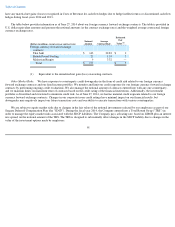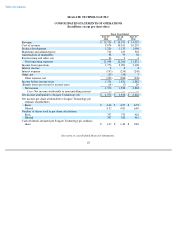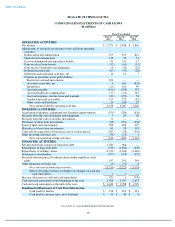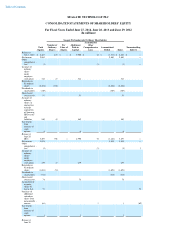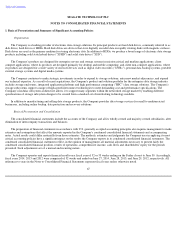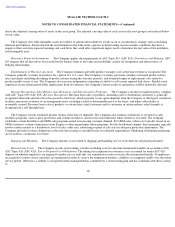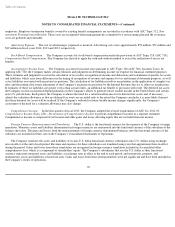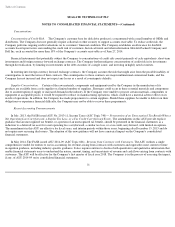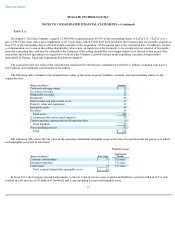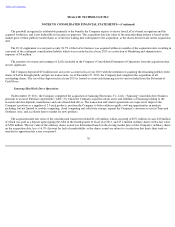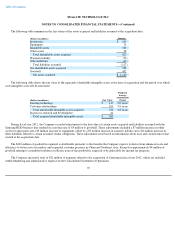Seagate 2013 Annual Report Download - page 75
Download and view the complete annual report
Please find page 75 of the 2013 Seagate annual report below. You can navigate through the pages in the report by either clicking on the pages listed below, or by using the keyword search tool below to find specific information within the annual report.
Table of Contents
SEAGATE TECHNOLOGY PLC
NOTES TO CONSOLIDATED FINANCIAL STATEMENTS—(Continued)
derive the adjusted carrying value of assets in the asset group. The adjusted carrying value of each asset in the asset group is not reduced below
its fair value.
The Company tests other intangible assets not subject to amortization whenever events occur or circumstances change, such as declining
financial performance, deterioration in the environment in which the entity operates or deteriorating macroeconomic conditions that have a
negative effect on future expected earnings and cash flows that could affect significant inputs used to determine the fair value of the indefinite-
lived intangible asset.
Derivative Financial Instruments. The Company applies the requirements of ASC Topic 815 (ASC 815), Derivatives and Hedging. ASC
815 requires that all derivatives be recorded on the balance sheet at fair value and establishes criteria for designation and effectiveness of
hedging relationships.
Establishment of Warranty Accruals. The Company estimates probable product warranty costs at the time revenue is recognized. The
Company generally warrants its products for a period of 1 to 5 years. The Company's warranty provision considers estimated product failure
rates and trends (including the timing of product returns during the warranty periods), and estimated repair or replacement costs related to
product quality issues, if any. The Company also exercises judgment in estimating its ability to sell certain repaired disk drives. Should actual
experience in any future period differ significantly from its estimates, the Company's future results of operations could be materially affected.
Revenue Recognition, Sales Returns and Allowances, and Sales Incentive Programs.
The Company's revenue recognition policy complies
with ASC Topic 605 (ASC 605), Revenue Recognition. Revenue from sales of products, including sales to distribution customers, is generally
recognized when title and risk of loss has passed to the buyer, which typically occurs upon shipment from the Company or third party warehouse
facilities, persuasive evidence of an arrangement exists, including a fixed or determinable price to the buyer, and when collectability is
reasonably assured. Revenue from sales of products to certain direct retail customers and to customers in certain indirect retail channels is
recognized on a sell-through basis.
The Company records estimated product returns at the time of shipment. The Company also estimates reductions to revenue for sales
incentive programs, such as price protection, and volume incentives, and records such reductions when revenue is recorded. The Company
establishes certain distributor and OEM sales programs aimed at increasing customer demand. For OEM sales, rebates are typically based on an
OEM customer's volume of purchases from Seagate or other agreed upon rebate programs. For the distribution channel, these programs typically
involve rebates related to a distributor's level of sales, order size, advertising or point of sale activity and price protection adjustments. The
Company provides for these obligations at the time that revenue is recorded based on estimated requirements. Marketing development programs
are recorded as a reduction to revenue.
Shipping and Handling. The Company includes costs related to shipping and handling in Cost of revenue for all periods presented.
Restructuring Costs. The Company records restructuring activities including costs for one-time termination benefits in accordance with
ASC Topic 420 (ASC 420), Exit or Disposal Cost Obligations. The timing of recognition for severance costs accounted for under ASC 420
depends on whether employees are required to render service until they are terminated in order to receive the termination benefits. If employees
are required to render service until they are terminated in order to receive the termination benefits, a liability is recognized ratably over the future
service period. Otherwise, a liability is recognized when management has committed to a restructuring plan and has communicated those actions
to
69



